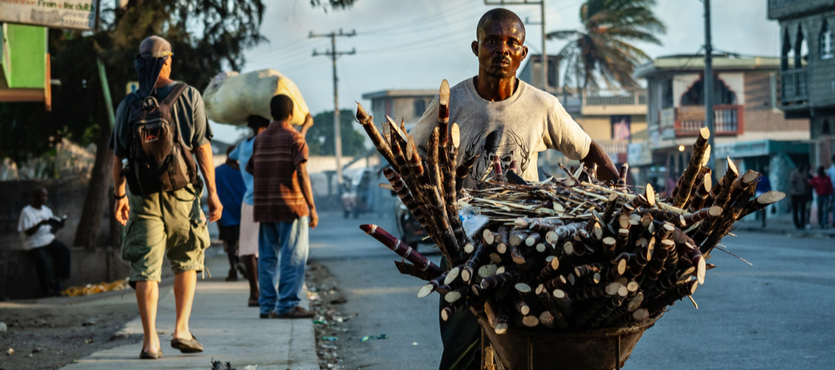The assassination of President Jovenel Moïse might go to the highest level, as authorities arrested a top security coordinator as part of an ongoing effort to bring the responsible person(s) to justice.
Jean Laguel Civil’s attorney says his client’s arrest is politically motivated. He was taken into custody as Jimmy “Barbecue” Cherizier, a Port-au-Prince gang leader, led a large group of protestors in the capital. Many of these people wore masks to conceal their identities. Cherizier is responsible for a number of massacres and other crimes, according to police. He is also the leader of the so-called G9, a collection of nine of the largest street gangs in Port-au-Prince.
More than two dozen suspects are in police custody as the assassination investigation is just getting underway.
How We Got Here
We take peaceful power transitions for granted in the United States, even if a leader meets an untimely demise. But in most countries, including Haiti, such transitions are an extremely rare luxury, even under ideal circumstances. A political assassination often has extreme ripple effects in a nation that can hardly withstand any instability.
The roots of this instability go back to Haiti’s French colonial days prior to a revolution which began in 1791. Over the years, the French systematically gutted most of Haiti’s natural resources. Indeed, a modern-day satellite image of Hispaniola, the island which Haiti and the Dominican Republic share, clearly shows the border between these two countries. The Dominican Republic, which has one of the largest economies in the Caribbean, has lush, fertile land. Haiti resembles a moonscape.
Haiti won its independence in 1804, but the heady days of freedom did not last long. Very few nations recognized the slave republic. The United States did not welcome a Haitian diplomat until 1862. As a result, Haiti temporarily split in two.
Then, in 1825, a large French fleet arrived in Haiti, determined to reconquer a country which was already falling apart. The French only left when the Haitians promised to pay an immense bounty. Soon, Haiti was spending 80% of its gross domestic product on debt retirement.
A series of emperors and would-be emperors came and went until the United States occupied the nation in 1915. The Marines imposed a rather brutal marital law regime. As many as 3,000 Haitians died between 1915 and the American departure in 1934.
Then, the United States played powerbroker for about 20 years, as a series of strongmen came and went. In 1956, François “Papa Doc” Duvalier became president. He soon declared himself president for life. Despite his excesses, the United States supported him, largely because of his anti-communist stance.
The Duvalier era lasted until 1986, when Jean-Claude “Baby Doc” Duvalier went into exile, as protests against his rule intensified and the Cold War waned. Then, you guessed it, a series of leaders came and went. The latest chapter in this saga is the aforementioned assassination of President Moïse. Acting president Ariel Henry has asked for U.S. troops to stabilize the country in advance of elections which are to be held late in 2021.
Contractors in Haiti
A significant number of private military contractors already have boots on the ground in Haiti. If regular servicemembers arrive, the number of contractors could increase.
Haitian private military contractors are primarily concerned with security and stability. The government’s authority over the country is largely theoretical. Street gangs control much of the large cities and warlords control many rural areas. A few contractors rumbling through the streets in Humvees might be the only security residents enjoy.
Because of this power structure, corruption is a serious problem as well. Even though foreign aid poured into Haiti after a 2010 earthquake, much of it never got to the people. A significant number of Haitians still live in tents.
If American military units come ashore, contractor responsibilities will probably shift to support roles.
These support roles include everything from cooks and doctors to mechanics and checkpoint guards. Frequently, contractors form much of the “tail” in what military planners call the T2T (Tooth to Tail) ratio. Combat troops, the tooth, are completely ineffective without an efficient support network, which is the tail.
Injury Compensation
Front-line contractors frequently sustain trauma injuries. Some of these trauma injuries are combat-related. But many are non-combat-related, like falls. Support contractors are prone to occupational diseases, such as hearing loss and repetitive stress disorder.
In both situations, the medical bills are very high, to say the least. Usually, health insurance companies refuse to pay injury-related expenses. So, without the Defense Base Act, these victims might have to pay these expenses out of pocket.
The DBA’s medical payment benefit usually applies to all reasonably necessary medical expenses, such as:
- Transportation costs, including medevac if needed,
- Hospitalization,
- Emergency care,
- Follow-up care,
- Medical devices,
- Prescription drugs, and
- Physical or occupational therapy.
The average injury-related medical bill usually exceeds $50,000. If medevac is necessary, these expenses could double.
Frequently, insurance companies use the reasonably necessary rule to reduce or deny compensation. Brain injury physical therapy is a good illustration. Usually, progress is very uneven in this area. Progress comes in fits and starts. If the victim hits a plateau, many insurance companies try to cut off funding.
Attorneys advocate for victims in these situations, so the money keeps flowing and they continue to improve. This means they can get back to work sooner. This outcome ultimately benefits everyone.
For more information about DBA eligibility, contact Barnett, Lerner, Karsen, Frankel & Castro, P.A.

